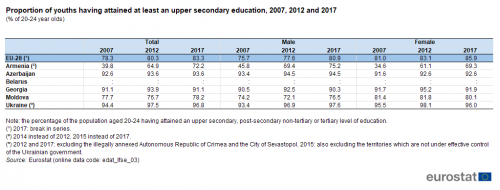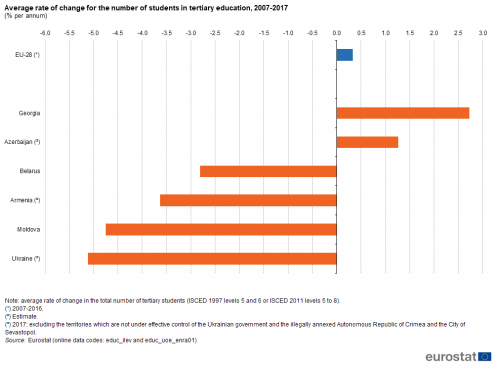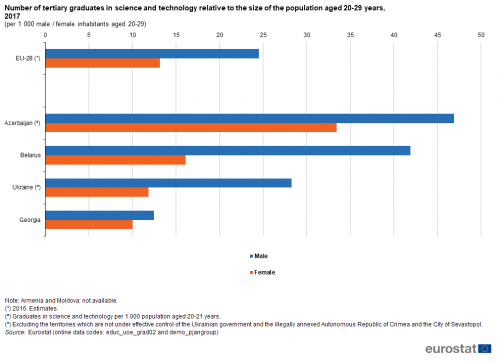Archive:European Neighbourhood Policy - East - education statistics
Data extracted in November 2018.
Planned article update: January 2020.
Highlights
Among the ENP-East countries, public expenditure on education relative to GDP was lowest in Armenia and Azerbaijan.
More than one fifth of the total number of pupils and students in Moldova attended a pre-primary school establishment, whereas in Belarus almost one quarter of the total attended a tertiary education establishment.
More than 90 % of the youth population in Ukraine, Azerbaijan and Georgia had completed at least an upper secondary level of education.
More than three fifths of the population aged 30-34 in Ukraine had completed a tertiary level of education.
Public expenditure on education as a share of GDP, 2007-2017
This article is part of an online publication; it presents information on a range of education statistics for the European Union (EU) and six countries that together form the European Neighbourhood Policy-East (ENP-East) region, namely, Armenia, Azerbaijan, Belarus, Georgia, Moldova and Ukraine. Note that data shown in this article for Georgia exclude the regions of Abkhazia and South Ossetia over which the government of Georgia does not exercise effective control and data for Moldova exclude Transnistria. The latest data for Ukraine generally exclude the territories which are not under effective control of Ukrainian government and the illegally annexed Autonomous Republic of Crimea and the City of Sevastopol (see specific footnotes for precise coverage).
The article includes information relating to expenditure on education, numbers of pupils and students, educational attainment among those aged 20-24, and a special focus on tertiary education.
Full article
Expenditure on education
Figure 1 shows the importance of public expenditure on education relative to gross domestic product (GDP) over the period 2007-2017. For the EU-28, this ratio fluctuated around 5.0 % during those years for which data are available (2007-2015). The increase observed in 2009 should be interpreted in its context, as the global financial and economic crisis resulted in GDP falling in 2009, while public educational expenditure continued to rise slightly; it was not until 2011 that the effects of austerity measures resulted in the level of educational expenditure stagnating across the EU-28 (as spending was unchanged compared with the year before).

(% of GDP)
Source: Eurostat (gov_10a_exp)
Many of the ENP-East countries had similar developments, insofar as they saw the relative importance of educational expenditure rising between 2008 and 2009, followed by a subsequent contraction in the relative size of education spending through to 2011. More recent data for the ENP-East countries shows a general increase in the relative importance of educational expenditure in Belarus and Georgia and a relatively stable situation in Azerbaijan and Armenia (since a fall in 2012). In Moldova there was a downward development after a peak in 2010, but the ratio in Moldova in 2017 remained nevertheless higher than in any of the other ENP countries. In 2017, public spending on education represented 5.5 % of GDP in Moldova, around 5 % in Ukraine (2016 data) and Belarus, just under 4 % in Georgia and less than 3 % in Azerbaijan and Armenia; note that the data for Armenia only concerns central government expenditure.
Numbers of pupils and students
Table 1 presents the latest data available showing the distribution of pupils and students across the various educational levels (classified according to the International Standard Classification of Education (ISCED 2011)). There were more than 108 million pupils and students attending educational establishments from pre-primary to tertiary education across the EU-28 in 2016, while the corresponding total for the six ENP-East countries was at least 12.6 million pupils and students (based on the latest available data for each country as shown in Table 1).

(thousand)
Source: Eurostat (educ_uoe_enrp01) and (educ_uoe_enra01)
An analysis of these data shows that 14.3 % of all pupils and students in the EU-28 attended pre-primary education (ISCED 2011 level 02) in 2016. The relative importance of this form of early childhood education varied considerably among the ENP-East countries in 2017, from less than one tenth (9.4 %) of the total number of pupils and students in Azerbaijan to more than one fifth (22.6 %) of the total number of pupils and students in Moldova.
Over a quarter (26.9 %) of all pupils and students in the EU-28 attended a primary education establishment in 2016. In 2017, shares for three of the ENP-East countries were slightly lower than this — within the range of 23.0 % to 24.0 % — while primary education accounted for a higher share of the total number of pupils and students in Armenia (27.4 %), Azerbaijan (30.7 %) and Georgia (41.7 %; excluding pre-primary education from the denominator for the total number of pupils and students).
At the other end of the educational system, 18.1 % of all pupils and students in the EU-28 attended tertiary education in 2016. Compared with the EU-28, a higher proportion of pupils and students attended tertiary education in 2017 in Georgia (20.2 %; excluding pre-primary education from the denominator for the total number of pupils and students), Belarus (22.8 %) and Ukraine (24.3 %), while the share of tertiary students in Armenia was only slightly below that in the EU-28, at 17.4 %.
Educational attainment among those aged 20-24 years
Education and training are seen as a basis for international competitiveness and a drive towards creating high-value, high-skill economies. Indeed, the EU’s goal of becoming a smart, sustainable and inclusive economy is, in part, founded upon the premise of developing its knowledge-based economy.
The share of the population aged 20-24 that reached at least an upper secondary educational level — otherwise referred to as the youth education attainment level — was 83.3 % in the EU-28 in 2017; note that from the 2014 reference year education statistics for the EU are based on the 2011 version rather than the 1997 version of ISCED. The latest data for 2017 marked an increase of 5.0 percentage points when compared with the corresponding share recorded in 2007 (see Table 2). Within the EU-28 there were differences in the youth education attainment level between the sexes, as the female youth education attainment level was, at 85.9 %, some 5.0 percentage points higher than the male level.

(% of 20-24 year olds)
Source: Eurostat (edat_lfse_03)
Among the ENP-East countries there were considerable differences in youth education attainment levels. In 2017, more than 9 in 10 members of the youth population (aged 20-24) had completed at least an upper secondary education in Ukraine (96.8 %), Azerbaijan (93.6 %) and Georgia (91.1 %), while the same ratio was 78.2 % in Moldova and 72.2 % in Armenia (2015 data). Differences between the sexes were quite varied across the ENP-East countries in 2017: for example, in Moldova the male youth education attainment level was 3.6 percentage points lower than the female level and in Armenia the rate for men was 5.9 percentage points higher (2015 data).
Focus on tertiary education
In many countries policymakers have increased their focus on human capital. Attempts have been made to raise the proportion of the workforce with a tertiary education and to improve access to lifelong learning opportunities, leading to higher participation rates in tertiary education (ISECD 2011 levels 5 to 8). The global financial and economic crisis may also have resulted — albeit temporarily — in more young people remaining in further education and/or training, as employment opportunities (especially among the youth population) were limited.
Within the EU-28 the number of tertiary students grew, on average, by 0.3 % per annum during the period 2007-2016. There were just under 20 million tertiary students in the EU-28 in 2016, equivalent to almost one in five (18.1 %) of the total population of pupils and students.
Somewhat fresher data are available for the ENP-East countries (covering the period 2007-2017). Georgia and Azerbaijan were the only ENP-East countries to report expansions in the number of tertiary students: the 2.7 % per year increase in Georgia and the 1.3 % per year increase in Azerbaijan were both higher than the 0.3 % per year increase recorded for the EU-28 (see Figure 2). In the four remaining ENP-East countries, there were relatively large falls in tertiary student numbers. Note that overall population numbers have been falling in some ENP-East countries for several years and that these reductions in the number of inhabitants may impact upon the absolute number of students in tertiary education, while the relative share of the population attaining higher levels of education continues to rise (see below for more details).

(% per annum)
Source: Eurostat (educ_ilev) and (educ_uoe_enra01)
Figure 3 shows the proportion of 30-34 year olds who had completed a tertiary level of education. Within the EU-28, this ratio rose at a rapid pace: from three tenths (30.10 %) of those aged 30-34 in 2007 to two fifths (39.9 %) of this subpopulation a decade later in 2017: as such, by 2017 the EU-28 had already reached its policy target set for 2020, namely 40 %.
Ukraine (63.0 %) and Georgia (44.6 %) reported higher proportions of persons aged 30-34 having completed a tertiary level of education than the corresponding proportion for the EU-28. Among the three other ENP-East countries for which data are available (Belarus, no data available), this ratio ranged from 24.1 % (Azerbaijan) to 37.1 % (Moldova).

(%)
Source: Eurostat (edat_lfse_03)
There has been considerable focus on differences between subjects that are studied by men and women at tertiary level. Figure 4 shows that the ratio of men graduating with a science or technology degree relative to the total male population aged 20-29; in 2016, this figure stood at 24.5 male graduates per 1 000 male inhabitants in the EU-28, which was almost twice as high as the corresponding ratio for women (13.1 per 1 000 female inhabitants).

(per 1 000 male / female inhabitants aged 20-29)
Source: Eurostat (educ_uoe_grad02) and (demo_pjangroup)
The ratio of men having graduated from a science or technology discipline per 1 000 male inhabitants aged 20-29 in Belarus was higher than in the EU-28, reaching 41.9 per 1 000 in 2017. The equivalent ratio for women was also higher in Belarus (16.1 per 1 000) for these disciplines than it was across the EU-28, but the gender gap was larger than in the EU-28. In Ukraine, the ratio for men was 28.2 %, somewhat higher than in the EU-28, while the ratio for women was 11.8 %, somewhat lower than in the EU-28, resulting also in a larger gender gap than in the EU-28. By contrast, in Georgia this ratio was lower than in the EU-28 for men and for women and furthermore, the gender gap was much narrower. Note that the data shown in Figure 4 for Azerbaijan have a different definition from those for the EU-28 and for the other ENP-East countries and are not directly comparable.
Source data for tables and graphs
Data sources
The data for ENP-East countries are supplied by and under the responsibility of the national statistical authorities of each country on a voluntary basis. The data result from an annual data collection cycle that has been established by Eurostat. These statistics are available free-of-charge on Eurostat’s website, together with a range of additional indicators for ENP-East countries covering most socio-economic topics.
Education statistics cover a range of subjects, including: expenditure, personnel, participation and attainment. The standards for international statistics on education are set by three organisations:
- the United Nations Educational, Scientific, and Cultural Organisation (UNESCO) institute for statistics (UIS);
- the Organisation for Economic Cooperation and Development (OECD);
- Eurostat, the statistical office of the European Union.
The main source of data for the EU-28 aggregate is a joint UNESCO/OECD/Eurostat (UOE) questionnaire on education systems and this is the basis for the core components of the Eurostat database on education statistics; Eurostat also collects data on regional enrolments and foreign language learning. EU-28 data on educational attainment are mainly provided through household surveys, in particular the EU labour force survey (LFS).
Note that the collection of data on education has recently undergone a considerable change as a result of the introduction of a new version of ISCED, namely ISCED 2011, replacing ISCED 1997. Longer time series are generally available on the basis of ISCED 1997, while data for the EU-28 and its Member States are often available on the basis of ISCED 2011 from the 2014 reference period.
Tables in this article use the following notation:
| Value in italics | data value is forecasted, provisional or estimated and is therefore likely to change; |
| : | not available, confidential or unreliable value; |
| – | not applicable. |
Context
Each EU Member State is responsible for its own education and training systems. As such, EU policy in this area is designed to support national action and address common challenges, by providing a forum for exchanging best practices. Through the strategic framework for European cooperation in education and training (known as ET 2020), which was adopted by the Council in May 2009, EU Member States identified four common objectives for 2020: making lifelong learning and mobility a reality; improving the quality and efficiency of education and training; promoting equity, social cohesion, and active citizenship; and enhancing creativity and innovation, including entrepreneurship, at all levels of education and training. The strategy sets a number of benchmarks in relation to education that are to be achieved by 2020, including:
- at least 95 % of children between the age of four and the age for starting compulsory primary education should participate in early childhood education;
- the share of early leavers from education and training should be less than 10 %;
- the share of low-achieving 15-year olds in reading, mathematics and science should be less than 15 %;
- the share of 30-34 year olds with tertiary educational attainment should be at least 40 %.
In 2014, progress was assessed and priorities were reviewed: as a result, in November 2015 the Council adopted a set of six new priorities for the period 2016-2020 based on a joint report (2015/C 417/04) from the European Commission and the EU Member States.
On 18 November 2015, the High Representative for Foreign Affairs and Security Policy and the European Commission jointly presented a review of the European Neighbourhood Policy (SWD(2015) 500 final) which underlined a new approach for the EU in relation to its eastern and southern neighbours, based on stabilising the region in political, economic, and security-related terms.
In cooperation with its ENP partners, Eurostat has the responsibility ‘to promote and implement the use of European and internationally recognised standards and methodology for the production of statistics, necessary for developing and monitoring policy achievements in all policy areas’. Eurostat undertakes the task of coordinating EU efforts to increase the statistical capacity of the ENP countries. Additional information on the policy context of the ENP is provided here.
Direct access to
- All articles on non-EU countries
- European Neighbourhood Policy countries — statistical overview — online publication
- Statistical cooperation — online publication
Books
Leaflets
- Basic figures on the European Neighbourhood Policy — East countries — 2018 edition
- Basic figures on the European Neighbourhood Policy — East countries — 2016 edition
- Basic figures on the European Neighbourhood Policy — East countries — 2015 edition
- Basic figures on the European Neighbourhood Policy — East countries — 2014 edition
- International trade for the European Neighbourhood Policy — East countries — 2016 edition
- European Neighbourhood Policy-East countries — Statistics on living conditions — 2015 edition
- European Neighbourhood Policy — East countries — Key economic statistics — 2014 edition
- European Neighbourhood Policy — East countries — Labour market statistics — 2014 edition
- European Neighbourhood Policy — East countries — Youth statistics — 2014 edition
- Population and social conditions (enpr_ps)
- ENP countries: education (enpr_pseduc)
- Science and technology (enpr_sc)
- ENP countries: science and technology (enpr_scienc)
- Eastern European Neighbourhood Policy countries (ENP-East) (ESMS metadata file — enpr_esms)